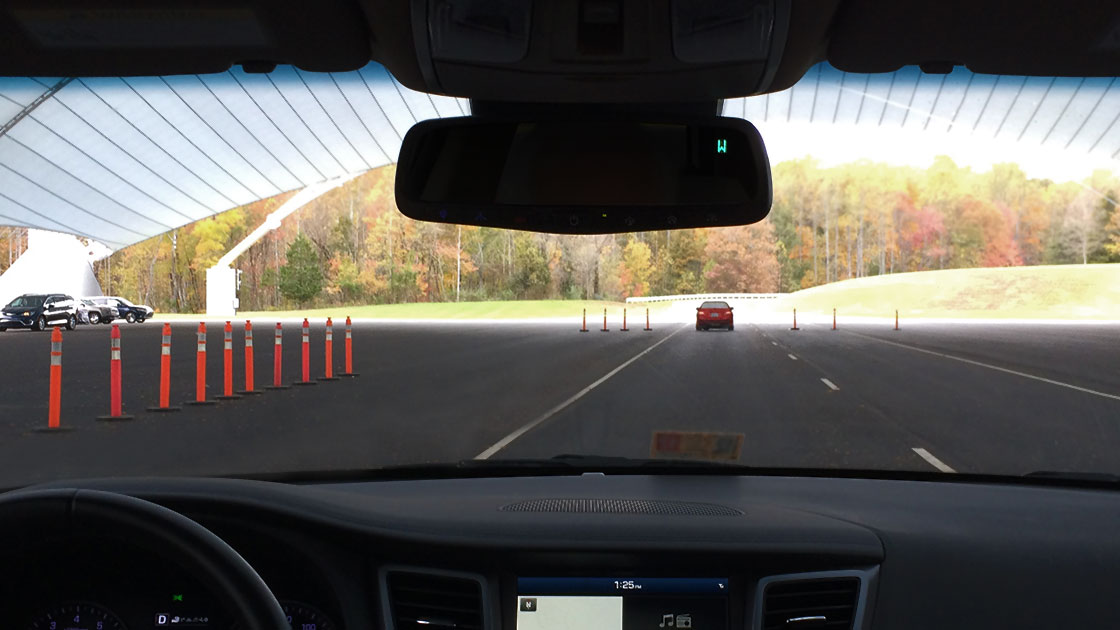Three more automakers fulfill pledge to make autobrake nearly universal
December 8, 2022

Three more automakers have fulfilled a voluntary pledge to equip nearly all the light vehicles they produce for the U.S. market with automatic emergency braking (AEB).
Mitsubishi, Nissan/Infiniti and Stellantis installed AEB on more than 95 percent of the vehicles they produced between Sept. 1, 2021, and Aug. 31, 2022, joining 12 automakers that fulfilled the voluntary commitment in previous years. Stellantis, which equipped only 43 percent of its vehicles with AEB in 2021, made the most progress.
“With Stellantis dramatically boosting the percentage of vehicles it equips with AEB, there’s been another big jump in the number of affordable cars and SUVs with this important safety feature,” IIHS President David Harkey said. “General Motors and Porsche also made substantial progress toward the goal.”
A total of 20 manufacturers joined the 2016 commitment brokered by the Insurance Institute for Highway Safety and the National Highway Traffic Safety Administration (NHTSA). They pledged to equip at least 95 percent of their light-duty cars and trucks with the crash avoidance technology by the production year that just began on Sept. 1, 2022. Light-duty vehicles are those with a gross vehicle weight rating of 8,500 pounds or less.
So far, Audi, BMW, Ford/Lincoln, Honda/Acura, Hyundai/Genesis, Mazda, Mercedes-Benz, Mitsubishi, Nissan/Infiniti, Stellantis, Subaru, Tesla, Toyota/Lexus, Volkswagen and Volvo have crossed the finish line early.
Honda/Acura, which crossed the finish line last year, dipped below the threshold due to supply chain issues, installing AEB on 93 percent of the vehicles it produced for the U.S. market during this reporting period. Once an automaker reaches the 95 percent mark, they aren’t required to continue filing reports, and neither BMW nor Tesla submitted data this time around.
Kia narrowly missed the cut this reporting period, increasing the percentage of its vehicles with AEB to 94 percent this reporting period from 89 percent last year.
General Motors, Jaguar Land Rover, and Porsche also made substantial progress, equipping around three-quarters of their light-duty vehicles with AEB, up from around 60 percent last year. Maserati’s numbers were essentially flat, with 71 percent equipped in the latest reporting period.
“The overwhelming number of vehicles produced with this critical safety technology means that consumers will receive safety benefits even if they aren’t actively shopping for them,” said Jennifer Stockburger, Director of Operations at Consumer Reports' Auto Test Center. “Additional capabilities that many of these systems also provide, such as pedestrian detection and the ability to function at highway speeds, have the potential to save even more lives."
To fulfill their commitment, manufacturers must attest that the AEB system on their vehicles meets certain performance standards. The forward collision warning feature must meet a subset of NHTSA’s current 5-Star Safety Ratings program requirements on the timing of driver alerts. The AEB must earn at least an advanced rating in the IIHS vehicle-to-vehicle front crash prevention evaluation. To earn that rating, the system must slow the vehicle by at least 10 mph in either the 12 or 25 mph test or 5 mph in both of the tests.
Most manufacturers’ standard systems earn a superior rating in the IIHS test, and many can also detect and avoid pedestrians. Because the vehicle-to-vehicle evaluation no longer effectively differentiates among systems, the Institute is dropping that test from the criteria for its Top Safety Pick and Top Safety Pick+ awards next year and investigating whether it needs to be replaced with a new one to drive further improvements. Meanwhile, a nighttime test of pedestrian AEB is being added to the requirements, as research has shown that most pedestrian detection systems don’t work well in the dark — when fatal pedestrian crashes are most common.
Along with the pledge to equip light-duty vehicles with AEB, automakers committed to installing the technology on vehicles with a gross vehicle weight rating of 8,501-10,000 pounds on a slightly longer timeline, by the production year that begins Sept. 1, 2025. Five automakers reported producing vehicles in that range for the U.S. market in the most recent year. Among them, Nissan reported all were equipped with AEB, Ford 76 percent and Stellantis 34 percent. Mercedes-Benz reported that none of its heavier vehicles were equipped with AEB, and General Motors did not report a percentage of equipped vehicles in this weight class.
The deadline for light-duty vehicles with manual transmissions is the production year that begins Sept. 1, 2024.
IIHS expects the voluntary commitment to prevent 42,000 crashes and 20,000 injuries by 2025. The estimate is based on IIHS research that found that front crash prevention systems with both forward collision warning and automatic emergency braking cut rear-end crashes by half.
| Percent of vehicles produced Sept. 1 to Aug. 31 with AEB As reported by manufacturer for light-duty vehicles 8,500 pounds or less gross vehicle weight. May exclude vehicles with manual transmissions. |
||
|---|---|---|
| 2021 | 2022 | |
| Hyundai/Genesis | 98 | 100 |
| Nissan/Infiniti | 93 | 100 |
| Subaru | 100 | 100 |
| Tesla | 100 | 100* |
| Volvo | 100 | 100 |
| BMW | 99 | 99* |
| Mitsubishi | 92 | 99 |
| Ford/Lincoln | 96 | 98 |
| Mercedes-Benz | 97 | 97 |
| Stellantis | 43 | 96 |
| Audi | 99 | 95+ |
| Mazda | 96 | 95+ |
| Toyota/Lexus | 97 | 95+ |
| Volkswagen | 98 | 95+ |
| Kia | 89 | 94 |
| Honda/Acura | 96 | 93 |
| Jaguar Land Rover | 60 | 75 |
| General Motors | 58 | 73 |
| Maserati | 72 | 71 |
| Porsche | 59 | 70 |
* Percentage carried over from earlier report. Companies are not required to submit updates after they meet the target.